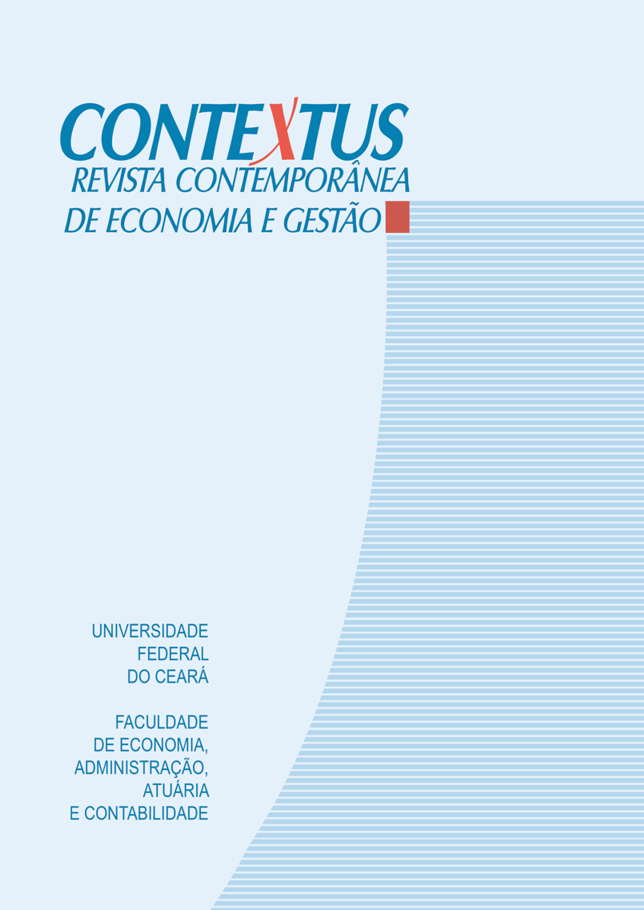“Érase una vez […]”: Estimulando la investigación gerencial a través de viñetas
DOI:
https://doi.org/10.19094/contextus.2023.83246Palabras clave:
viñetas, investigación, metodología, instrumento, recolección de datosResumen
El propósito de este ensayo metodológico es presentar y reflexionar sobre algunos aspectos a ser considerados al momento de construir y utilizar viñetas como instrumento de recolección de datos. Se presentan características, ventajas y posibles limitaciones de las viñetas, circunstancias prácticas de uso, formatos de uso frecuente. Estos aspectos abordados en conjunto contribuyen al uso de viñetas en la investigación en Administración, independientemente de la perspectiva de los estudios. Siendo la viñeta un instrumento de recolección de datos poco utilizado en la Administración, este artículo puede ser una guía para futuros investigadores sirviendo de fuente para aquellos más interesados en conocer las características para realizar un estudio mediante viñetas.
Descargas
Citas
Aguinis, H., & Bradley, K. J. (2014). Best practice recommendations for designing and implementing experimental vignette methodology studies. Organizational Research Methods, 17(4), 351-371. https://doi.org/10.1177/1094428114547952
Ashta, A., Stokes, P., & Hughes, P. (2018). Change management in Indo-Japanese cross-cultural collaborative contexts: Parallels between traditional Indian philosophy and contemporary Japanese management. Journal of Organizational Change Management, 31(1), 154-172. https://doi.org/10.1108/JOCM-05-2017-0201
Azman, H., & Mahadhir, M. (2017). Application of the vignette technique in a qualitative paradigm. GEMA Online Journal of Language Studies, 17(4), 27-44. https://doi.org/10.17576/gema-2017-1704-03
Aznar, S. C. (1990). Vinheta: Do pergaminho ao vídeo. Universidade de São Paulo.
Barter, C., & Renold, E. (2000). I wanna tell you a story: Exploring the application of vignettes in qualitative researchwith children and young people. International Journal of Social Research Methodology, 3(4), 307-323. https://doi.org/10.1080/13645570050178594
Berg Johansen, C., & De Cock, C. (2018). Ideologies of time: How elite corporate actors engage the future. Organization, 25(2), 186-204. https://doi.org/10.1177/1350508417725592
Bradbury-Jones, C., Taylor, J., & Herber, O. R. (2014). Vignette development and administration: A framework for protecting research participants. International Journal of Social Research Methodology, 17(4), 427-440. https://doi.org/10.1080/13645579.2012.750833
Brasil (2016). Resolução n. 510, de 07 de abril de 2016. Ética na Pesquisa na área de Ciências Humanas e Sociais. Brasília: CNS.
Carù, A., & Cova, B. (2015). Co-creating the collective service experience. Journal of Service Management, 26(2), 276-294. https://doi.org/10.1108/JOSM-07-2014-0170
Dunn, K., & Harness, D. (2019). Whose voice is heard? The influence of user-generated versus company-generated content on consumer scepticism towards CSR. Journal of Marketing Management, 35(9-10). https://doi.org/10.1080/0267257X.2019.1605401
Finch, J. (1987). The vignette technique in survey research. Sociology, 21(1), 105-114.
Gould, D. (1996). Using vignettes to collect data for nursing research studies: how valid are the findings? Journal of Clinical Nursing, 5, 207-212.
Gray, D., Royall, B., & Malson, H. (2019). Falando hipoteticamente - Uso de Vinhetas como método qualitativo independente. In V. Braun, V. Clarke, & D. Gray (Eds.), Coleta de dados qualitativos: um guia prático para técnicas textuais, midiáticas e virtuais (p. 385). Editora Vozes.
Hassan, S., Pandey, S., & Pandey, S. K. (2021). Should managers provide general or specific ethical guidelines to employees: Insights from a mixed methods study. Journal of Business Ethics, 172(3), 563-580. https://doi.org/10.1007/s10551-020-04442-3
Herskovits, M. J. (1950). The hypothetical situation: A technique of field research. Southwestern Journal of Anthropology, 6(1), 32-40.
Hoelz, J. C., & Bataglia, W. (2015). O uso de vinhetas em estudos qualitativos. Investigação Qualitativa em Ciências Sociais, 3(1), 64-69.
Hoelz, J. C., & Bataglia, W. (2019). Eventos prejudiciais à reputação corporativa: Um estudo exploratório utilizando a técnica de vinhetas. Ámbitos - Revista Internacional de Comunicación, 44, 33-53. https://doi.org/10.12795/ambitos.2019.i44.03
Hughes, R. (1998). Considering the vignette technique and its application to a study of drug injecting and HIV risk and safer behaviour. Sociology of Health and Illness, 20(3), 381-400. https://doi.org/10.1111/1467-9566.00107
Hughes, R., & Huby, M. (2002). The application of vignettes in social and nursing research. Journal of Advanced Nursing, 37(4), 382-386.
Hughes, R., & Huby, M. (2004). The construction and interpretation of vignettes in social research. Social Work and Social Sciences Review, 11(1), 36-51. https://doi.org/10.1921/17466105.11.1.36
Jenkins, N., Bloor, M., Fischer, J., Berney, L., & Neale, J. (2010). Putting it in context: The use of vignettes in qualitative interviewing. Qualitative Research, 10(2), 175-198. https://doi.org/10.1177/1468794109356737
Jennings, J. E., Edwards, T., Jennings, P. D., & Delbridge, R. (2015). Emotional arousal and entrepreneurial outcomes: Combining qualitative methods to elaborate theory. Journal of Business Venturing, 30(1), 113-130. https://doi.org/10.1016/j.jbusvent.2014.06.005
Kirschbaum, C., & Hoelz, J. C. (2014). A confiança em situações ambivalentes e incongruentes: A utilização de vinhetas como método exploratório. RAM - Revista de Administração Mackenzie, 15(3), 42-68. https://doi.org/10.1590/1678-69712014/administracao.v15n3p42-68
Kirwan, J. R., De Saintonge, D. C., Joyce, C. R., & Currey, H. L. (1983). Clinical judgment in rheumatoid arthritis. I. Rheumatologists’ opinions and the development of ‘paper patients’. Annals of the Rheumatic Diseases, 42, 644-647.
Leal, W., Filho, Skouloudis, A., Brandli, L. L., Salvia, A. L., Avila, L. V., & Rayman-Bacchus, L. (2019). Sustainability and procurement practices in higher education institutions: Barriers and drivers. Journal of Cleaner Production, 231, 1267-1280. https://doi.org/10.1016/j.jclepro.2019.05.202
Liu, Y., & Xu, C. (2021). Consumer intention to purchase and corporate social responsibility: Evidence from an experiment in an entrepreneurial context. Journal of Consumer Behaviour. https://doi.org/10.1002/cb.1987
Macêdo, N. M., & Bispo, M. de S. (2022). Qualitative vignettes drawing on real cases as method in organizational research. Canadian Journal of Administrative Sciences / Revue Canadienne Des Sciences de l’Administration, 2022, 1-11. https://doi.org/10.1002/cjas.1692
McKelvie, A., Haynie, J. M., & Gustavsson, V. (2011). Unpacking the uncertainty construct: Implications for entrepreneurial action. Journal of Business Venturing, 26(3), 273-292. https://doi.org/10.1016/j.jbusvent.2009.10.004
Mudrack, P. E., & Mason, E. S. (2021). Vignette themes and moral reasoning in business contexts: The case for the defining issues test. Journal of Business Ethics, 181, 979-995. https://doi.org/10.1007/s10551-021-04944-8
Mullen, E., Alexander, J., & Coates, N. (2019). ‘Think about what our industry stands for….’: Exploring the impact of external factors on line manager perceptions of graduate employability. Journal of Higher Education Policy and Management, 1, 1-14. https://doi.org/10.1080/1360080X.2019.1646381
Murphy, J., Hughes, J., Read, S., & Ashby, S. (2021). Evidence and practice: a review of vignettes in qualitative research. Nurse Researcher, 29(3), 8-14. https://doi.org/10.7748/nr.2021.e1787
Murphy, K. R., Herr, B. M., Lockhart, M. C., & Maguire, E. (1986). Evaluating the performance of paper people. Journal of Applied Psychology, 71, 654-661.
Paddam, A., Barnes, D., & Langdon, D. (2010). Constructing vignettes to investigate anger in multiple sclerosis. Nurse Researcher, 17(2), 60-73. https://doi.org/10.7748/nr2010.01.17.2.60.c7463
Petrini, P. (2004). Um estudo crítico sobre o significado das vinhetas da Rede Globo. Acta Scientiarum - Human and Social Sciences, 26(1), 123-133. https://doi.org/10.4025/actascihumansoc.v26i1.1568
Riley, A. H., Critchlow, E., Birkenstock, L., Itzoe, M. L., Senter, K., Holmes, N. M., & Buffer, S. W. (2021). Vignettes as research tools in global health communication: A systematic review of the literature from 2000 to 2020. Journal of Communication in Healthcare, 14(4), 283-292. https://doi.org/10.1080/17538068.2021.1945766
Roberts, M. C., Johnson, A. Q., & Beidleman, W. B. (1984). The role of socioeconomic status on children’s perceptions of medical and psychological disorders. Journal of Clinical Child Psychology, 13, 243-249. https://doi.org/10.1080/15374418409533197
Sampson, H., & Johannessen, I. A. (2020). Turning on the tap: The benefits of using ‘real-life’ vignettes in qualitative research interviews. Qualitative Research, 20(1), 56-72. https://doi.org/10.1177/1468794118816618
Sandri, O., Holdsworth, S., & Thomas, I. (2016). Vignette question design for the assessment of graduate sustainability learning outcomes. Environmental Education Research, 24(3). https://doi.org/10.1080/13504622.2016.1263280
Sauer, S. J. (2011). Taking the reins: The effects of new leader status and leadership style on team performance. Journal of Applied Psychology, 96(3), 574-587. https://doi.org/10.1037/a0022741
Skilling, K., & Stylianides, G. J. (2019). Using vignettes in educational research: A framework for vignette construction. International Journal of Research and Method in Education, 43(5), 541-556. https://doi.org/10.1080/1743727X.2019.1704243
Spalding, N. J., & Phillips, T. (2007). Exploring the use of vignettes: from validity to trustworthiness. Qualitative Health Research, 17(7), 954-962. https://doi.org/10.1177/1049732307306187
Thomas, R., Darby, J. L., Dobrzykowski, D., & van Hoek, R. (2021). Decomposing Social sustainability: Signaling theory Insights into supplier selection decisions. Journal of Supply Chain Management, 57(4). https://doi.org/10.1111/jscm.12247
Törrönen, J. (2018). Using vignettes in qualitative interviews as clues, microcosms or provokers. Qualitative Research Journal, 18(3), 276-286. https://doi.org/10.1108/QRJ-D-17-00055
Walster, E. (1966). Assignment of responsibility for an automobile accident. Journal of Personality and Social Psychology, 3, 73-79.
Wason, K. D., Polonsky, M. J., & Hyman, M. R. (2002). Designing vignette research in marketing. Australasian Marketing Journal, 10(3), 41-58. https://doi.org/10.1016/S1441-3582(02)70157-2
Wilks, T. (2004). The use of vignettes in qualitative research into social work values. Qualitative Social Work, 3(1), 78-87. https://doi.org/10.1177/1473325004041133
Yanow, D., & Tsoukas, H. (2009). What is reflection-in-action? A phenomenological account. Journal of Management Studies, 46(8), 1339-1364. https://doi.org/10.1111/j.1467-6486.2009.00859.x
Descargas
Publicado
Cómo citar
Número
Sección
Licencia
The authors, while doing the submission, accept the notice below:
We authors hold the copyright related to our paper and transfer Contextus journal the right for the first publication with a Creative Commons’ international license of the modality Attribution – Non-commercial 4.0, which in turn allows the paper to be shared providing that both the authorship and the journal’s right for initial release are acknowledged.
Furthermore, we are aware of our permission to take part in additional contracts independently for non-exclusive distribution of the version of our work published in this journal (e.g. publishing it in an institutional repository or as a book chapter), while acknowledging both the authorship and the journal’s initial publication.
We also certify that the paper is original and up to this date has not been released in any other journal, Brazilian or of another nationality, either in Portuguese or another language, as well as it has not been sent for simultaneous publication in other journals.
Last, we not only know that plagiarism is not tolerated by Contextus but also certify the paper presents the sources of passages from cited works, including those authored by ourselves.









3.png)


1.jpg)



1.jpg)


1.jpg)






.jpg)



1.jpg)

1.jpg)


1.jpg)

1.jpg)
1.jpg)
2.png)




1.jpg)
2.jpg)

1.jpg)





1.jpg)


1.jpg)
1.jpg)
